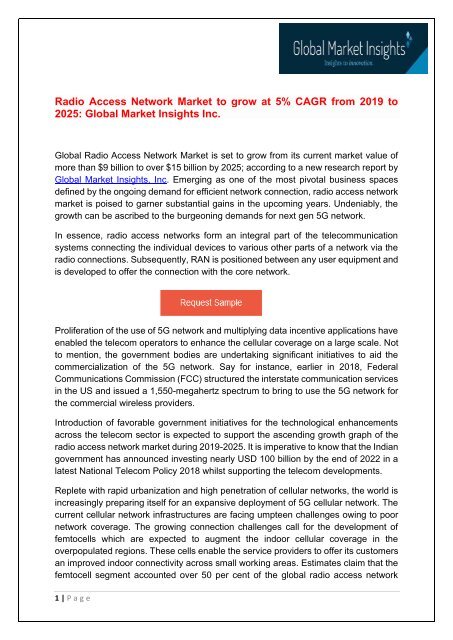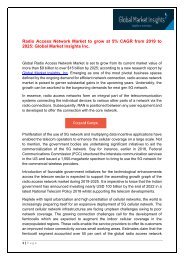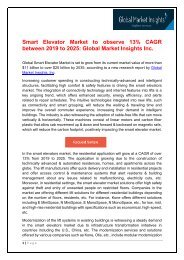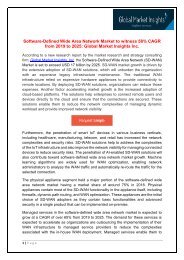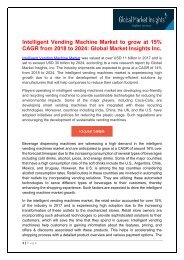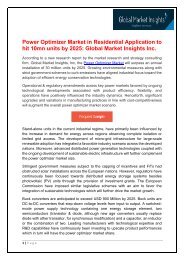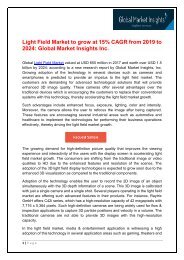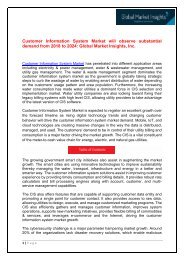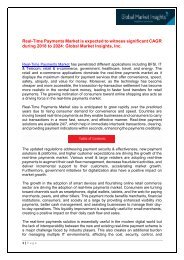PDF-Radio Access Network
Create successful ePaper yourself
Turn your PDF publications into a flip-book with our unique Google optimized e-Paper software.
<strong>Radio</strong> <strong>Access</strong> <strong>Network</strong> Market to grow at 5% CAGR from 2019 to<br />
2025: Global Market Insights Inc.<br />
Global <strong>Radio</strong> <strong>Access</strong> <strong>Network</strong> Market is set to grow from its current market value of<br />
more than $9 billion to over $15 billion by 2025; according to a new research report by<br />
Global Market Insights, Inc. Emerging as one of the most pivotal business spaces<br />
defined by the ongoing demand for efficient network connection, radio access network<br />
market is poised to garner substantial gains in the upcoming years. Undeniably, the<br />
growth can be ascribed to the burgeoning demands for next gen 5G network.<br />
In essence, radio access networks form an integral part of the telecommunication<br />
systems connecting the individual devices to various other parts of a network via the<br />
radio connections. Subsequently, RAN is positioned between any user equipment and<br />
is developed to offer the connection with the core network.<br />
Proliferation of the use of 5G network and multiplying data incentive applications have<br />
enabled the telecom operators to enhance the cellular coverage on a large scale. Not<br />
to mention, the government bodies are undertaking significant initiatives to aid the<br />
commercialization of the 5G network. Say for instance, earlier in 2018, Federal<br />
Communications Commission (FCC) structured the interstate communication services<br />
in the US and issued a 1,550-megahertz spectrum to bring to use the 5G network for<br />
the commercial wireless providers.<br />
Introduction of favorable government initiatives for the technological enhancements<br />
across the telecom sector is expected to support the ascending growth graph of the<br />
radio access network market during 2019-2025. It is imperative to know that the Indian<br />
government has announced investing nearly USD 100 billion by the end of 2022 in a<br />
latest National Telecom Policy 2018 whilst supporting the telecom developments.<br />
Replete with rapid urbanization and high penetration of cellular networks, the world is<br />
increasingly preparing itself for an expansive deployment of 5G cellular network. The<br />
current cellular network infrastructures are facing umpteen challenges owing to poor<br />
network coverage. The growing connection challenges call for the development of<br />
femtocells which are expected to augment the indoor cellular coverage in the<br />
overpopulated regions. These cells enable the service providers to offer its customers<br />
an improved indoor connectivity across small working areas. Estimates claim that the<br />
femtocell segment accounted over 50 per cent of the global radio access network<br />
1 | P a g e
market share in 2018 and is probable to grow at a commendable pace over the<br />
forecast period.<br />
The lack of proper connectivity and network across the suburban and rural areas has<br />
led to an urgent need for the deployment of small cell connectivity systems. Evidently,<br />
the traditional LTE systems have been proven to be highly expensive and are complex<br />
due to unending requirements by the mobile operators. On account of the requirement<br />
for efficient communication, the demand for RAN solutions is exponentially mounting<br />
in these regions. The reason for considering small cells over macrocells as base<br />
stations for cellular network is the potential of innumerable small cells to be positioned<br />
rapidly over a large area as compared to other base stations. The placement of large<br />
volumes of small cells in the suburban and rural regions would allow the segment to<br />
depict a CAGR of 6 per cent through the projected timeframe.<br />
Notably, Asia-Pacific would be one of the rapidly evolving regions in the radio access<br />
network market with an anticipated growth rate of approximately 8 per cent through<br />
2025. The emergence and high penetration of 5G cellular networks across the region,<br />
chiefly led by India and China, will act as a primary driver for the regional RAN industry<br />
growth. According to credible sources, India has securely held a prominent position in<br />
the global market on the grounds of sales of more than 40 million smartphones during<br />
the third quarter of 2017. Evidently, several industry majors are building up alliance<br />
with other technology companies to advance the innovative radio access solutions. A<br />
2 | P a g e
major breakthrough in this is the partnership between Rakuten and Intel to analyze a<br />
complete virtualized radio access network market.<br />
Browse key industry insights spread across 280 pages with 505 market data tables &<br />
28 figures & charts from the report, “<strong>Radio</strong> <strong>Access</strong> <strong>Network</strong> Market” in detail along<br />
with the table of contents @ https://www.gminsights.com/industry-analysis/radioaccess-network-market<br />
Table of Content (TOC-)<br />
Chapter 1. Methodology & Scope<br />
1.1. Methodology<br />
1.1.1. Initial data exploration<br />
1.1.2. Statistical model and forecast<br />
1.1.3. Industry insights and validation<br />
1.1.4. Scope<br />
1.1.5. Definitions<br />
1.1.6. Methodology & forecast parameters<br />
1.2. Data Sources<br />
1.2.1. Secondary<br />
1.2.1.1. Paid sources<br />
1.2.1.2. Public sources<br />
1.2.2. Primary<br />
Chapter 2. Executive Summary<br />
2.1. RAN industry 360º synopsis, 2014 - 2025<br />
2.1.1. Business trends<br />
2.1.2. Regional trends<br />
3 | P a g e
2.1.3. Component trends<br />
2.1.3.1. Communication infrastructure trends<br />
2.1.3.1.1. Cell sites trends<br />
2.1.3.1.1.1. Small cell trends<br />
2.1.3.2. Service trends<br />
2.1.4. Connectivity technology trends<br />
2.1.5. Deployment region trends<br />
Chapter 3. RAN Industry Insights<br />
3.1. Introduction<br />
3.2. Industry segmentation<br />
3.3. Industry landscape, 2014 – 2025<br />
3.4. RAN benefits<br />
3.5. RAN architecture<br />
3.6. Industry ecosystem analysis<br />
3.7. RAN evolution<br />
3.8. Technology & innovation landscape<br />
3.8.1. Artificial Intelligence (AI) and Machine learning<br />
3.8.2. Internet of Things (IoT)<br />
3.9. Regulatory landscape<br />
3.9.1. Global<br />
3.9.1.1. International Telecommunication Union (ITU)<br />
3.9.1.2. 3GPP<br />
3.9.2. North America<br />
4 | P a g e
3.9.2.1. Federal Communications Commission (FCC), U.S.<br />
3.9.2.2. The National Institute of Standards and Technology (NIST),<br />
U.S.<br />
3.9.3. Europe<br />
3.9.3.1. European Telecommunications Standards Institute (ETSI)<br />
<strong>Radio</strong> Equipment Directive (2014/53/EU)<br />
3.9.3.2. General Data Protection Regulation (GDPR)<br />
3.9.4. Asia Pacific<br />
3.9.4.1. <strong>Radio</strong>communications Act 1992 (Australia)<br />
3.9.4.2. Telecom Regulatory Authority of India (TRAI)<br />
3.9.5. Latin America<br />
3.9.5.1. Public Telecommunications Policy (Decree 4733/2003)<br />
3.9.5.2. Brazilian Telecommunications Model (LGT)<br />
3.9.6. Middle East and Africa<br />
3.9.6.1. Independent Communications Authority of South Africa<br />
(ICASA) under ECA<br />
3.9.6.2. Telecommunications Regulatory Authority (TRA), UAE<br />
3.10. Industry impact forces<br />
3.10.1. Growth drivers<br />
3.10.1.1. Increasing smartphone penetration<br />
3.10.1.2. Adoption of <strong>Network</strong> Function Virtualization (NFV) and<br />
Software Defined <strong>Network</strong>ing (SDN) technologies<br />
3.10.1.3. 5G commercialization<br />
3.10.1.4. Demand for improved network coverage<br />
3.10.1.5. Favorable government initiatives<br />
5 | P a g e
3.10.2. Industry pitfalls & challenges<br />
3.11. Porter’s analysis<br />
3.10.2.1. Lack of standardization in spectrum allocation<br />
3.10.2.2. Interference in cell sites<br />
3.10.2.3. Security related issues<br />
3.12. PESTEL analysis<br />
3.13. Growth potential analysis<br />
Browse complete Table of Contents (ToC) of this research report @<br />
https://www.gminsights.com/toc/detail/radio-access-network-market<br />
About Global Market Insights<br />
Global Market Insights, Inc., headquartered in Delaware, U.S., is a global market<br />
research and consulting service provider; offering syndicated and custom research<br />
reports along with growth consulting services. Our business intelligence and industry<br />
research reports offer clients with penetrative insights and actionable market data<br />
specially designed and presented to aid strategic decision making. These exhaustive<br />
reports are designed via a proprietary research methodology and are available for key<br />
industries such as chemicals, advanced materials, technology, renewable energy and<br />
biotechnology.<br />
Contact Us:<br />
Arun Hegde<br />
Corporate Sales, USA<br />
Global Market Insights, Inc.<br />
Phone: 1-302-846-7766<br />
Toll Free: 1-888-689-0688<br />
Email: sales@gminsights.com<br />
Web: https://www.gminsights.com<br />
6 | P a g e


